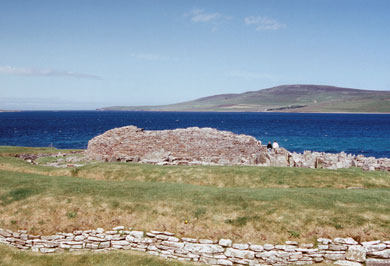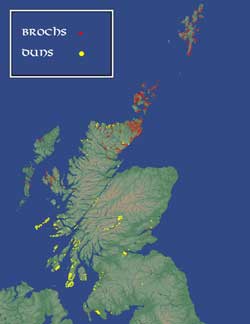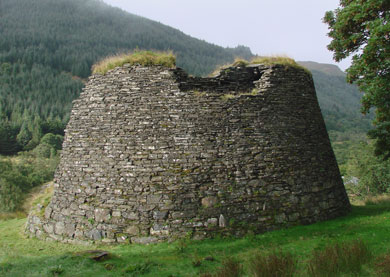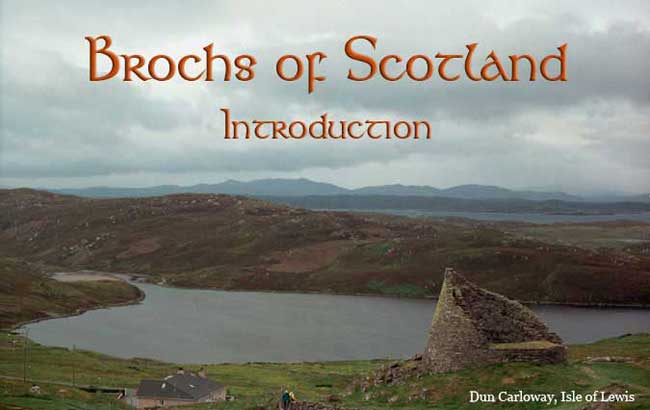
Introduction
The word ‘broch’ derives from the Norse borg (“fort”) and is used by archaeologists to describe the circular, prehistoric drystone towers found mainly in the north and west of 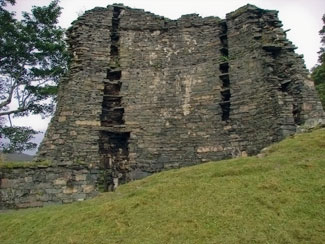 Scotland. Dun Telve (right), which is near the village of Glenelg on the Lochalsh coast, opposite the Isle of Skye, is a good example.
Scotland. Dun Telve (right), which is near the village of Glenelg on the Lochalsh coast, opposite the Isle of Skye, is a good example.
When the antiquarians began to study these monuments in the eighteenth and nineteenth centuries, they assumed that they were fortifications, equating them with the 15th century Peel towers of the Scottish Borders, the strongholds of the local lairds. They knew that brochs were much earlier—perhaps Viking or Pictish products of the Dark Ages. However, when actual excavations began in the mid-nineteenth century, they produced a good deal of material that was known to be Roman in date. Since the majority of brochs are on or very near the coast, they revised their thinking and interpreted them as a response to Roman slaving expeditions and military activity in the first century AD. This theory was undone by the development of radiocarbon dating techniques in the 1950’s. These now show that quite a number of the brochs were built several centuries before the first Romans arrived on the scene.
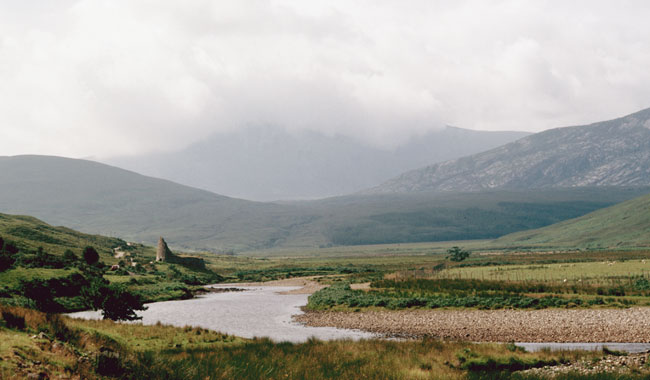
Dun Donaigl Broch. Strathmore, Sutherland
There are at least a hundred or so in the highlands and islands and there are many more sites whose identity is unclear because they are either too damaged or have not been properly investigated. Typically the walls are hollow for much of their height with an inner and an outer ‘skin’ bonded together by lintels. The cavities are known as galleries and were normally accessible 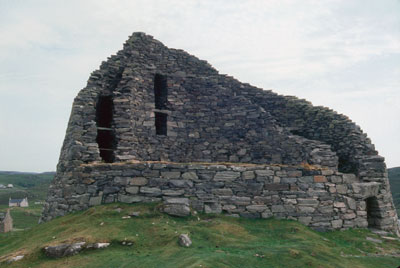 from a staircase which wound at least part way around the interior of the wall. Dun Carloway (left), on the Atlantic coast of Lewis in the Outer Hebrides, is a good example.
from a staircase which wound at least part way around the interior of the wall. Dun Carloway (left), on the Atlantic coast of Lewis in the Outer Hebrides, is a good example.
On the west coast and in the Hebrides, they normally extend the whole height of the tower (the so-called ‘ground-galleried’ type) while in Caithness and Sutherland, and the Northern Isles the tendency is towards solid bases with galleries only occurring from the first floor and up. It is thought that the one type evolved out of the other but there is some disagreement as to which had priority. Since neither type is exclusive to its supposed territory, it may be that there is some other explanation for the distinction.
In many instances there were cells that opened onto the interior of the structure at ground level or higher but there are no other openings apart from the long entrance passage—no windows for example. In most cases the interiors had been badly disturbed but, where features have survived, there was generally the remains of a central hearth and partitions around the perimeter of the space. Many brochs have scarcements—narrow ledges on the inner face of the walls—designed to support the woodwork for a roof or the floor of an upper storey.

Mousa Broch. Shetland
Recently the assumption that they were defensive works has come under question. Many of them are poorly situated to serve as fortifications—they are overlooked by higher ground or have no reliable supply of water. The only broch with a parapet at the top (or even access to the top) is Mousa on Shetland and none of them have any windows, so mounting an active defence would have been difficult to say the least. There is also the matter of their proximity. The Glenelg brochs are only about a kilometre apart and are within full view of one another, and they are very thick on the ground in Orkney. At best they might have served as ‘bolt holes’ but even then a little patience and a good fire would have been all any attacker needed to smoke out the defenders. It is now widely believed

